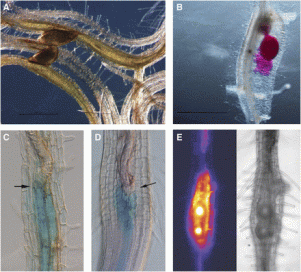- شما هیچ آیتمی در سبد خرید خود ندارید
- قیمت کل: 0 تومان
Plant-parasitic nematodes are microscopically small animals that cause global annual crop losses of at least 80 billion dollars (Nicol et al., 2011). The evolution of nematodes into plant parasites occurred several times, resulting in diverse interaction modes with the plant (Smant et al., 2018). We will focus this review on the sedentary cyst nematodes (CN) and root-knot nematodes (RKN), as they are the foremost studied due to their economic importance (Jones et al., 2013) and fascinating liaison with plants in the form of nematode feeding sites (Box 1).

Plant-parasitic nematodes and their impact on plant gene regulation. A, Two females of the beet CN H. schachtii feeding on Arabidopsis roots. Picture courtesy of Anju Verma. B, Female of the rice RKN M. graminicola on rice roots, with egg mass, stained pink with acid fuchsin staining. Picture courtesy of Zobaida Lahari. C and D, GUS assays on Arabidopsis roots infected with H. schachtii showing up-regulation of the DR5-promoter (blue color; C) at 24 h after inoculation and the IAA14-promoter (D) at 2 d post inoculation. Black arrows point to nematode heads. Reprinted with permission from Grunewald et al., 2008. E, Up-regulation of the LAX3-promoter after H. schachtii infection in Arabidopsis roots with LAX3-YFP construct: (left) fluorescence image; (right) brightfield image. Pictures courtesy of Chris Lee.
Nematodes establish feeding sites by recruiting specific plant developmental pathways, involving hormonal cross talk. At the same time, nematodes need to suppress plant defense and its interacting hormone pathways. This interface between development and defense results in a complex pattern in which it is difficult to unravel the specific roles of different plant hormones. Therefore, we present a simplified model for describing the roles of hormones in plant-nematode interactions in this review. Auxin, as the key regulator, and cytokinin, as its modulator, are the primary plant hormones involved in cell division and differentiation (Benková et al., 2003; Pernisová et al., 2009). Jasmonate (JA) and salicylate (SA) are the principal plant defense hormones (Mur et al., 2006). Other hormones modulate and cross talk with these principal hormones and with each other, and can have different effects depending on the specific host-nematode interaction.
Besides the classical phytohormones, small, secreted peptide hormones shape plant development; remarkably, nematodes have evolved plant peptide hormone (PPH) effector mimics to facilitate parasitism. Recent studies have revealed a diversity of these peptides, which we will discuss in the latter half of this review.



